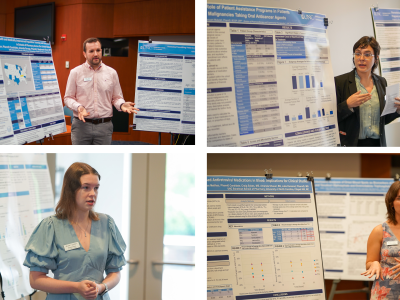August 20, 2009
“Anyone know what this is? Class? Anyone? Anyone? Anyone seen this before? The Laffer Curve. Anyone know what this says?”—Ben Stein in Ferris Bueller’s Day Off
It’s an iconic moment in movie history as the economic professor drones on and on, vainly trying to elicit a response from a near-catatonic class. It’s just a movie, but it does illustrate the challenges educators face in making sure their students are engaged in class and are understanding the material.
 “It’s funny because it’s true,” says Adam Persky, PhD, clinical associate professor and associate director of the Center for Educational Excellence in Pharmacy. “A whole classroom of students only sort of nodding yes is a poor way of demonstrating knowledge and comprehension.”
“It’s funny because it’s true,” says Adam Persky, PhD, clinical associate professor and associate director of the Center for Educational Excellence in Pharmacy. “A whole classroom of students only sort of nodding yes is a poor way of demonstrating knowledge and comprehension.”
Faculty at the UNC Eshelman School of Pharmacy felt there had to be a better way. During the 2008–2009 academic year, they tested the idea of using technology to gather instant responses from an entire class. In a pilot program, the School tested an audience response system in some second-year courses. Students were issued wireless devices that have come to be known as clickers. The clickers resemble remote controls with buttons that correllate to different responses to an instructor’s inquiries.
“As an example, you can use the clickers at the beginning of a class to ascertain what foundational knowledge the students are coming in with,” Persky says. “If you’re going to discuss hypertension, you might ask what is high-blood pressure, what controls blood pressure, or what is normal blood pressure. That way you can see what information the students have and whether that information is correct.”
You could also lecture for ten to twenty minutes and then ask a few questions to see if students are understanding the material. Students can see how they compare to the rest of the class, which can be especially valuable because individual students often feel like they are the only ones “not getting it,” Persky says.
He credits associate clinical professor Jo Ellen Rodgers, who had used the devices at the UNC School of Medicine, with introducing them to pharmacy.
“My students loved using the clickers,” Rodgers says. “They liked being able to apply the information they were getting and to assess their understanding of it before they left the classroom.”
The pilot project was assessed by surveys of both faculty and students. The major findings from the assessment were that
- 96 percent of the faculty who completed the survey favored full implementation of the audience-response system;
- faculty felt using the audience response system was an improvement to previously used techniques to assess students’ ability to recall facts, apply concepts, and elicit student participation; and
- students felt the audience-response system helped them maintain interest during class and indicated that it helped them gauge their own understanding of the material.
Based on the results of the pilot project, the School decided to implement the audience-response system throughout the curriculum. All incoming students are required to purchase a students response device (the clicker) along with their books and other class materials. The clickers cost thirty dollars.
Latest News

Dean Angela Kashuba receives Carolina Alumni Faculty Service Award

RASP poster presentations capture student research


